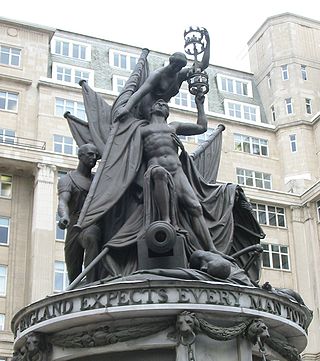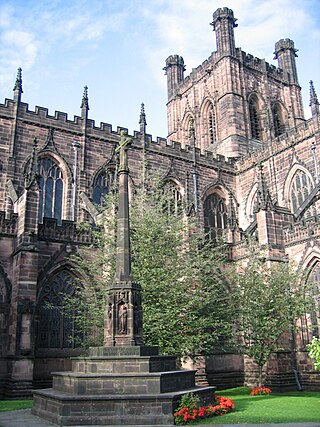History
Following the First World War, the people of Crewe were slow to approve plans for the erection of a monument to the town's 700 soldiers who had fallen in the combat. The town already had a war memorial, the Boer War Memorial, which had been erected in Queen's Park in 1902–03. It was hoped that there could be a joint monument with the London and North Western Railway, the main employers and land owners in the town, but they already had their own monument at Euston station in London. Eventually the council's War Memorial Sub-Committee decided in 1922 to erect a monument in Market Square. This was to be financed by public subscription, and it was hoped that the railway company would contribute to the cost. Seven models were submitted for consideration, and the committee chose the one designed by Walter Gilbert depicting a figure of Britannia in bronze. [1] Gilbert was the art director of the founders Martyns of Cheltenham, who were commissioned to cast the sculpture. [1]
The foundations for the memorial were laid in September 1923. It was unveiled on 14 June 1924 by General Sir Ian Hamilton, and dedicated by the Bishop of Chester, Luke Paget. The total cost of the memorial was £1,600, of which £600 was given by the railway company. [1] Following later wars and conflicts, plaques containing the names of those lost in the Second World War, the Falklands War, the Gulf War, and other conflicts were added. [2] In 2004 Crewe and Nantwich Borough Council decided to make improvements to Market Square which would result in the memorial being moved. In November 2005 it was taken to the National Conservation Centre in Liverpool for restoration. The memorial was installed in Municipal Square in October 2006. [1]

St John's Gardens is an open space in Liverpool, England, to the west of St George's Hall. The gardens are part of the William Brown Street conservation area, and comprise one of the two open spaces within Liverpool's World Heritage Site. It has been a Green Flag site since 2003. The gardens contain ornamental flower beds, and memorials to notable people of the city.

The Nelson Monument is a monument to Admiral Horatio Nelson, in Exchange Flags, Liverpool, England. It was designed by Matthew Cotes Wyatt and sculpted by Richard Westmacott. It stands to the north of the Town Hall and was unveiled in 1813.

The equestrian statue of Viscount Combermere stands on an island in Grosvenor Road, Chester, Cheshire, England, opposite the entrance to Chester Castle. It commemorates his successful military career, and was made by Carlo Marochetti. It is recorded in the National Heritage List for England as a designated Grade II* listed building.

Chester War Memorial stands in the grounds of Chester Cathedral in Chester, Cheshire, England. It was designed by Frederick Crossley and Thomas Rayson, and commemorates those who were lost in the two World Wars. The memorial is recorded in the National Heritage List for England as a designated Grade II listed building.

The Boer War Memorial, also known as the South African War Memorial, stands in a prominent position in Queens Park, Crewe, England. It was erected in memory of local soldiers who had served or fallen in the Boer War, and consists of a bronze statue of soldier in uniform standing on a column on a stone plinth. The monument was unveiled in 1903, and contains plaques with the names of those who were lost in the war. It is recorded in the National Heritage List for England as a designated Grade II listed building.

Widnes War Memorial stands in Victoria Park, Widnes, Cheshire, England. It commemorates the serving men who lost their lives in the two world wars. The memorial consists of an obelisk in Portland stone on a plinth of York stone. It was unveiled in 1921, and more names were added in 1950. The monument is recorded in the National Heritage List for England as a designated Grade II listed building.

Macclesfield Cenotaph is a World War I memorial in Park Green, Macclesfield, Cheshire, England. It was unveiled in 1921, and consists of a stone pillar and pedestal and three bronze statues. One statue is that of a mourning female, and the others comprise Britannia laying a wreath over a soldier who had died from gassing, an unusual subject for a war memorial at the time. The memorial is recorded in the National Heritage List for England as a designated Grade II* listed building.

The Statue of John Laird stands on the west side of Hamilton Square, Birkenhead, Merseyside, England. It commemorates the life of John Laird, a local ship builder, politician and benefactor. The statue was sculpted by Albert Bruce-Joy, and unveiled in 1877 by Lord Tollemache. It is recorded in the National Heritage List for England as a designated Grade II listed building.

Birkenhead War Memorial, or Birkenhead Cenotaph, stands in Hamilton Square, Birkenhead, Merseyside, England, opposite the Town Hall. It consists of a cenotaph in Portland stone with carved figures and panels in Westmorland stone. The memorial was designed by Lionel Budden, and the sculptor was H. Tyson Smith. It was unveiled in 1925 by Lieutenant-General Sir Richard H. K. Butler. The memorial is recorded in the National Heritage List for England as a designated Grade II* listed building.

Moulton War Memorial stands in Main Road, Moulton, Cheshire, England. It consists of a marble statue of a soldier standing on a sandstone pedestal, and is surrounded by a wrought iron fence. The memorial was designed by Samuel Welsby, and unveiled in 1920. It is recorded in the National Heritage List for England as a designated Grade II listed building.

The Monument to Captain John Francis Egerton stands in the grounds of the Oulton Estate, Little Budworth, Cheshire, England. John Francis Egerton died in 1846 as the result of injuries sustained in the First Anglo-Sikh War. The memorial was designed by George Gilbert Scott and William Bonython Moffatt, and is recorded in the National Heritage List for England as a designated Grade II* listed building.

The Boer War Memorial stands in the shopping precinct of Winsford, Cheshire, England. It consists of the statue of a soldier in uniform standing on a plinth, and it was unveiled in 1906. It originally stood on a different site in the town and was moved to its present position in the 1960s. In addition to recording the names of those who were lost in the conflict, it also contains the names of those who survived.

The Statue of Edward VII stands in Kings's Gardens, Stanley Road, Bootle, Sefton, Merseyside, England. It was erected to commemorate the Coronation of King Edward VII and consists of a bronze statue of Edward VII on a granite pedestal. The sculptor was George Wade. The statue was given to the borough by the local Member of Parliament, and stands on land given to the borough by Lord Derby. It was unveiled by Lady Derby in 1904.

The Statue of Queen Victoria stands on the western side of Victoria Square, St Helens, Merseyside, England. It was created after the death of Queen Victoria and given to the town by Colonel William Windle Pilkington, mayor of St Helens in 1902, and a member of the Pilkington glass manufacturers in the town. Pilkington commissioned George Frampton to design it. Frampton used the same model for the figure of the queen for two other statues, but placed it on thrones and pedestals of different designs. The St Helens statue was unveiled by the Earl of Derby in 1905. Originally placed in the centre of Victoria Square, it was moved to a position on the west side of the square in 2000. The statue is recorded in the National Heritage List for England as a designated Grade II* listed building.

A Memorial to Queen Victoria stands in Woodhouse Moor, Leeds, West Yorkshire, England.

The Lifeboat Monument, St Annes, stands on South Promenade, St Annes, Fylde, Lancashire, England. It commemorates the death of 13 lifeboatmen from St Annes who were lost in the attempt to rescue the crew of the German barque Mexico that had been driven into a sandbank in a gale in December 1886. The lifeboat from Southport also lost 14 of its 16 man crew in the disaster. The monument depicts a lifeboatman looking out to sea and standing on a rock-like plinth. It is recorded in the National Heritage List for England as a designated Grade II listed building.

Southport War Memorial is in London Square, Lord Street, Southport, Merseyside, England. It consists of an obelisk flanked by two colonnades in the form of Greek temples. Outside the colonnades are memorial gardens, each containing a Pool of Remembrance and fountains. The memorial was designed by the local architects Grayson and Barnish, and the carving was executed by Herbert Tyson Smith. It was unveiled in 1923 by the Earl of Derby. Following the Second World War and subsequent conflicts further inscriptions and names have been added. The memorial is recorded in the National Heritage List for England as a designated Grade II* listed building.

A statue of William Shakespeare, by the sculptor Giovanni Fontana after an original by Peter Scheemakers, has formed the centrepiece of Leicester Square Gardens in London since 1874.

St Saviour's War Memorial is a war memorial on Borough High Street, in the former parish of Southwark St Saviour, to south of the River Thames in London. It became a Grade II listed building in 1998 and was upgraded to Grade II* in 2018.

The monument to the King's Liverpool Regiment is a war memorial in St John's Gardens in the city centre of Liverpool, England. The memorial commemorates those members of the King's Regiment (Liverpool) who lost their lives on campaign in the Second Anglo-Afghan War (1878–1880), the Third Anglo-Burmese War (1885–1887) and the Second Boer War (1899–1902). It was funded by a public subscription and with the support of the Corporation of Liverpool. It was unveiled on 4 August 1905 by Field Marshal Sir George White. The monument is a rare example of a large-scale public regimental memorial from the pre-First World War era. Its central figure is that of Britannia with other statues showing soldiers of the regiment in 1685, 1743 and 1902.






















